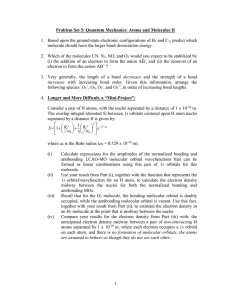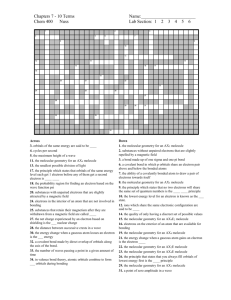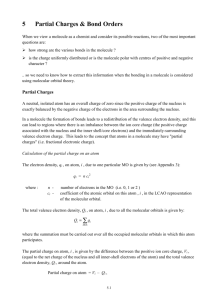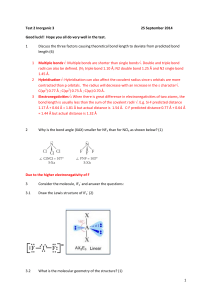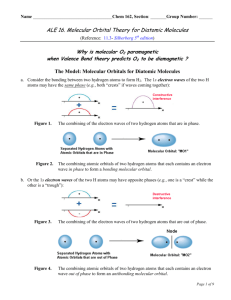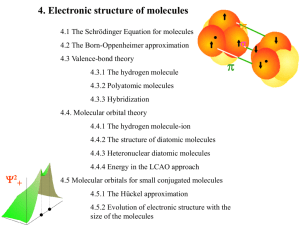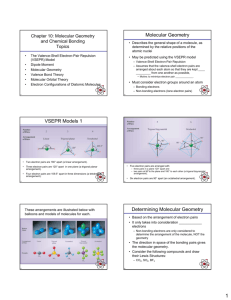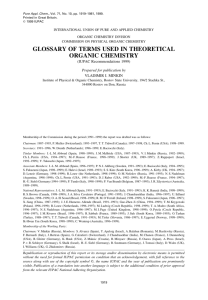6: 21, 25, 26, 51, 62, 67, 69
advertisement
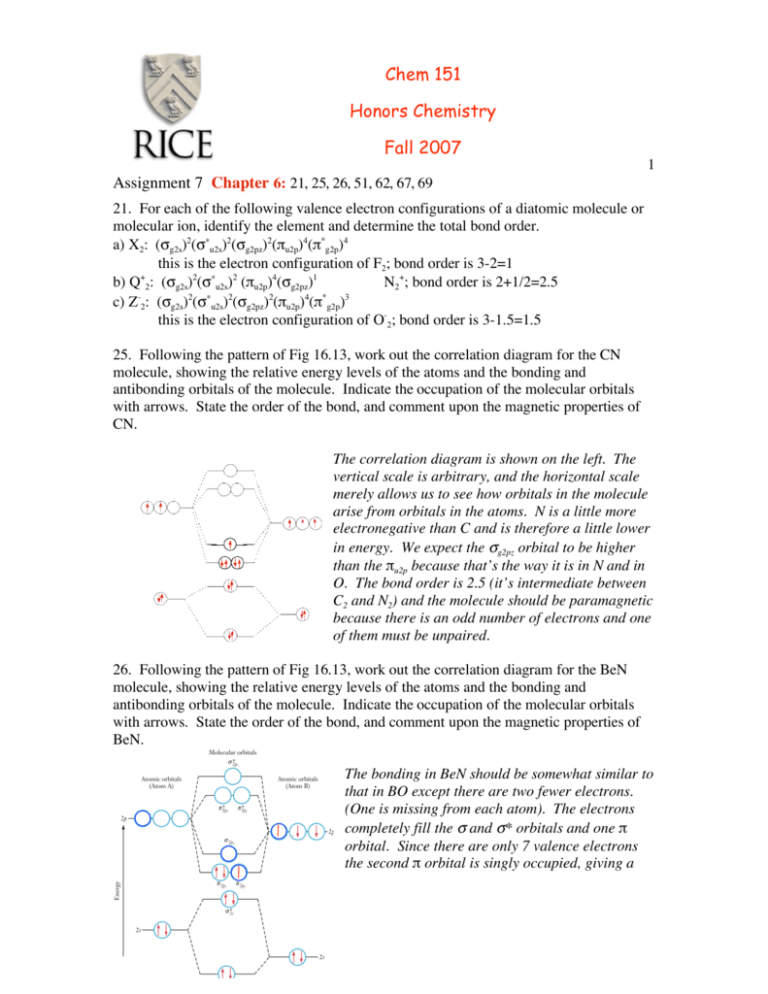
Chem 151 Honors Chemistry Fall 2007 1 Assignment 7 Chapter 6: 21, 25, 26, 51, 62, 67, 69 21. For each of the following valence electron configurations of a diatomic molecule or molecular ion, identify the element and determine the total bond order. a) X2: (σg2s)2(σ∗u2s)2(σg2pz)2(πu2p)4(π*g2p)4 this is the electron configuration of F2; bond order is 3-2=1 + b) Q 2: (σg2s)2(σ∗u2s)2 (πu2p)4(σg2pz)1 N2+; bond order is 2+1/2=2.5 c) Z-2: (σg2s)2(σ∗u2s)2(σg2pz)2(πu2p)4(π*g2p)3 this is the electron configuration of O-2; bond order is 3-1.5=1.5 25. Following the pattern of Fig 16.13, work out the correlation diagram for the CN molecule, showing the relative energy levels of the atoms and the bonding and antibonding orbitals of the molecule. Indicate the occupation of the molecular orbitals with arrows. State the order of the bond, and comment upon the magnetic properties of CN. The correlation diagram is shown on the left. The vertical scale is arbitrary, and the horizontal scale merely allows us to see how orbitals in the molecule arise from orbitals in the atoms. N is a little more electronegative than C and is therefore a little lower in energy. We expect the σg2pz orbital to be higher than the πu2p because that’s the way it is in N and in O. The bond order is 2.5 (it’s intermediate between C2 and N2) and the molecule should be paramagnetic because there is an odd number of electrons and one of them must be unpaired. 26. Following the pattern of Fig 16.13, work out the correlation diagram for the BeN molecule, showing the relative energy levels of the atoms and the bonding and antibonding orbitals of the molecule. Indicate the occupation of the molecular orbitals with arrows. State the order of the bond, and comment upon the magnetic properties of BeN. The bonding in BeN should be somewhat similar to that in BO except there are two fewer electrons. (One is missing from each atom). The electrons completely fill the σ and σ* orbitals and one π orbital. Since there are only 7 valence electrons the second π orbital is singly occupied, giving a Assignment 7 Chapter 6: 21, 25, 26, 51, 62, 67, 69 2 bond order of 1.5. Since there is an unpaired electron the molecule is paramagnetic. 51. Draw a Lewis electron dot diagram for each of the following molecules and ions. Formulate the hybridization for the central atom in each case and give the molecular geometry. a) sp3 tetrahedral Cl Cl Cl C Cl O C O O F F H C H H H Be H b) sp2 linear c) p octahedral (bent) d) sp3 pyramidal (electron repulsion from lp distorts away from tetrahedral) e) sp linear 62. Discuss the nature of the bonding in the nitrate ion (NO3-). Draw the possible Lewis resonance diagrams for this ion. Use the VSEPR theory to determine the steric number, the hybridization of the central N atom, and the geometry of the ion. Show how the use of resonance structures can be avoided by introducing a delocalized π molecular orbital. What bond order does the molecular orbital model predict for the N-O bonds in the nitrite ion? There are 3 resonance structures such as the figure on right. The VSEPR O theory says the steric number is 3 and the molecule should be planar, with a N bond angle = 120°. The molecular orbital treatment should be similar to O O that of CO2 discussed in the text, except that two more electrons need to be accommodated (one for N, and one for the negative charge. We thus expect sp2 hybridization on the N atom, each overlapping with a p orbital on the O to give three pσ bonds. The remaining N p orbital is perpendicular to the plane and will overlap the p orbitals on O perpendicular to the plane to give π and π* NO orbitals. The other p orbitals in plane will be occupied by nonbonding electrons. The correlation diagram is shown on the right. This results in 4 bonds divided between three pairs giving three bonds of order 1.333, which is the result of the resonance structures. 67. a)The ionization energy of H2 is greater than that of H, but that of O2 is lower than that of O. Explain. Assignment 7 Chapter 6: 21, 25, 26, 51, 62, 67, 69 3 According to MO theory, the electrons in H2 (σg1s)2 lie lower in energy than in either atom, so they are harder to remove. In O2 the electron configuration is (σg2s)2(σ∗u2s)2(σg2pz)2(πu2p)4(π*g2p) and ionization removes an antibonding electron, which is not bound as tightly as the outermost electron in the O atom. b) What predictions have you for the ionization energies in F and F2. F2 has two more antibonding electrons than O2 and should be easier to ionize than F. The NIST webbook gives IE(F)= 17.42282eV and IE(F2)= 15.697 ± 0.003eV confirming our reasoning. 69. is The molecular orbital of the ground state of a heteronuclear diatomic molecule AB ! mol = Ca! a + Cb! b If a bonding electron spends 90% of its time in an orbital ψa on atom A and 10% of its time in ψb on atom B, what are Ca and Cb? The probability of finding the electron in a region dV is ψ2dV. Thus the probability of finding the electron in dV is ψmol2dV = ! 2 mol = ( Ca! a + Cb! b ) = C 2 a! 2 a + C 2 b! 2 b + 2CaCb! a! b 2 = C 2 a! 2 a + C 2 b! 2 b since we can ignore the overlap, and since we assume the atomic volumes are the same C2a≈0.9 and Ca≈.95 Assignment 7 Chapter 6: 21, 25, 26, 51, 62, 67, 69 4

